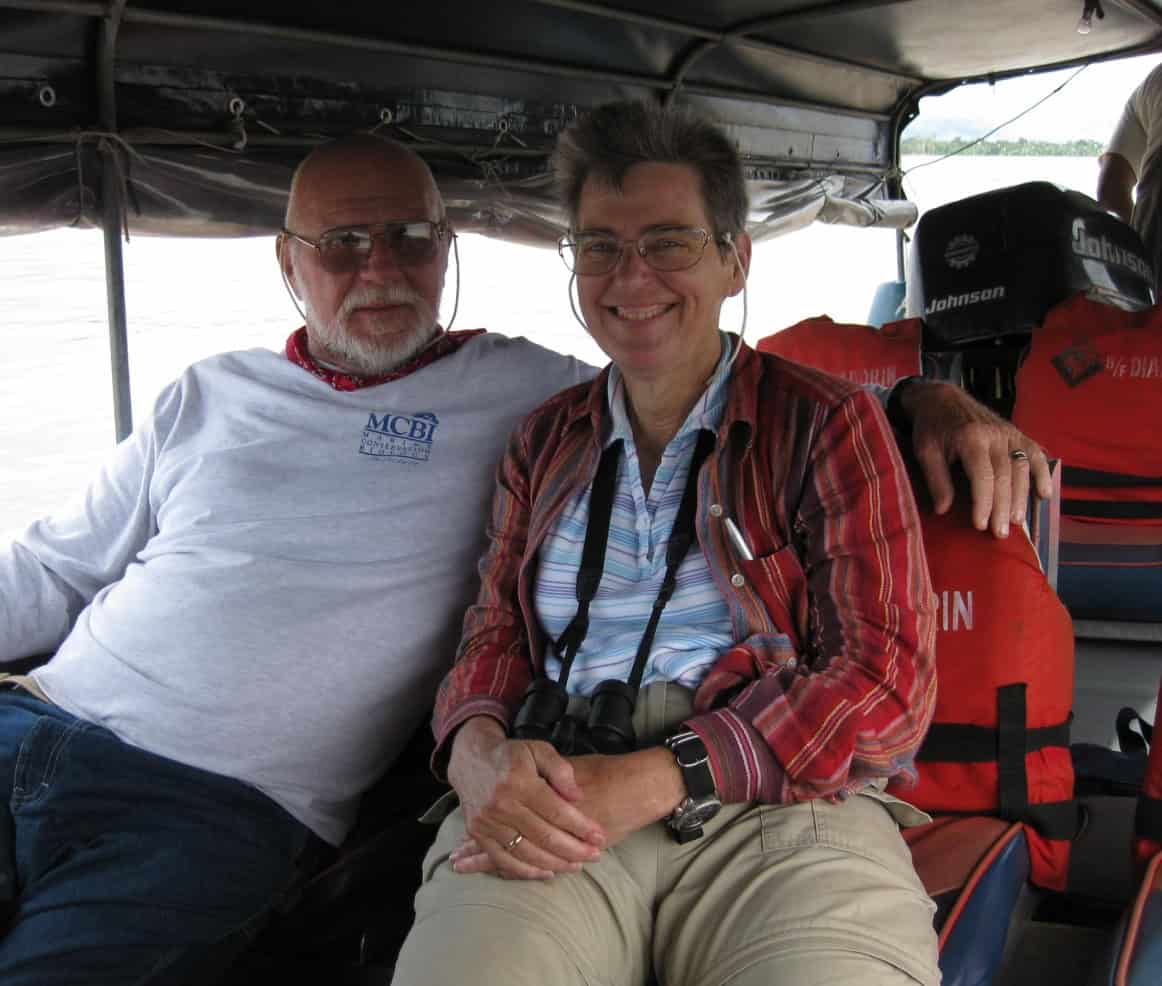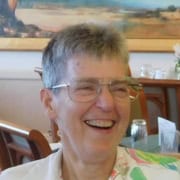A husbandly note —
From the time that Daphne started announcing her upcoming scheduled death, letters, cards and emails flowed in, mostly from friends at the Rogue Valley Manor retirement community. This, I thought, was a great improvement over the normal funeral procedures, in that both parties were able to benefit from the exchanges and expressions of affection and gratitude. After her death, the number and diversity of messages to me increased, until I began to wonder if I had been married to some sort of goddess for 34 years without noticing it. The answer was yes. As befits her name, Daphne was well suited for a position in the Greek pantheon — beings who operated at a very high level, and who possessed both extraordinary powers and a full complement of human attributes. Life with Daphne was never boring.
Starting at the very beginning of the baby boom, her trajectory through the subsequent 74 years passed through enormous scientific and societal changes, especially for women. In spite of knowing her for almost half her life, I was not very knowledgeable about the accomplishments and experiences of the other half, relying mostly on scattered anecdotes.
If that was my situation, many others must be even more vague about the many facets of the person they knew as Daphne. I decided to try to assemble a broader overview of her life by building on other memories as well as my own. The notes that follow include excerpts about Daphne and her life from some messages received, as well as some contributions of my own. Many of the items are presented anonymously, as I have not requested permission to quote (which I assume for close friends and mutual colleagues).
I hope they help to flesh out appreciation and understanding of Daphne and her life.
Bob Buddemeier 03/18/21
Daphne in the Peace Corps (1966-68)
So sorry, really, to hear of Daphne’s passing. She was a friend of my wife Kitsi and I from our first days in Peace Corps training in Hilo. She lived in the next cabin, when we all were assigned simple wood cabins to repair and occupy for several months. She always had a cheerful ‘good morning’ and always was a bright star in our training group of 120 or so very bright trainees. As a kid from the Arizona desert, I didn’t know people like her until our PC days and she remains an inspiration.
Daphne more Peace Corps — Daphne taught science in Mersing, Malaysia. When the driver of a car she was riding in ran over and killed a rather large cobra, Daphne retrieved the body and took it to school, where she skinned it. She mounted the skin on a long board and attached the board to the wall — were it remained for many years. (told to RWB)
Daphne still more Peace Corps — She took me to a reunion of her Peace Corps “class” near their training site in the island of Hawai’i. As we were going on a group excursion, one of the men turned to her and said “I remember going with you to watch the rabbits mating!” (RWB)
And more…
I was very saddened and taken aback when I got an email from Howard telling some of us that our friend, Daphne, had died. I met her in 1966 when we were both in training for Peace Corps service in Malaysia. We were both slated to be science teachers so we were together in various training sessions much of the time. It was such a joy to have known her. She was full of energy, outgoing, had a good sense of humor, very bright and had the curiosity that made here a very good researcher. Most of all she had a strong sense of right and fairness that is a model for the rest of us. I had hoped that one time our paths would cross and we could meet in person but alas that now will not happen. My memories of her are all good ones. I share your loss.
—————————————————————————————————————————————————————————————————————
Daphne the scientist (and more)
………..The coincidence: I was reminded of her last week when I was in my campus office, continuing to sort 40 years of accumulated academic stuff. Among the books and monographs that continue to be spared as “keepers” caught my eye: Daphne’s edited volume on the Biomedical Importance of Marine Organisms (well ahead of the vogue) and her book with Gerry Allen on anemonefishes and their host sea anemones. These two alone are a testament to the breadth and depth of her interests, as are her collaborations with geologists/geochemists and paleontologists (I think of you and Stanley here). All of this is atop her substantial body of systematic publications (where she was again ahead of the curve in applying molecular genetic approaches to cnidarians), and your joint seminal paper on the possible adaptive advantage of coral bleaching, not to mention her reputation as evinced by her membership on national and international committees and working groups. The passing first of John Pearse, then of Daphne, was the loss of two modern luminaries in natural history (sens. lat.).
I realized how long it had been since we communicated when I discovered, by chance a few years ago, the wonderfully apt and familiarly terse epigraph for Chapter 1 in my natural and cultural history of corals: “The term ‘coral’ is neither scientific nor precise.” For me, this embodies the symbiotic relationship between you and Daphne. [Malcolm (J. Malcolm SHICK Professor Emeritus of Zoology & Oceanography University of Maine)]
——————————————————————————————————————————————————————————————————
Daphne in Papua New Guinea— Daphne made a number of trips to PNG, where some of her research on the anemone-anemonefish symbiosis was done. She took many photos of the exotic environment, and some of them were assembled in an early edition of The Complement, a resident newsletter of the Rogue Valley Manor retirement community.
Click here to view.
Heading home from the Peruvian Amazon
————————————————————————————————————————————————————
Just before reading your email, I was reading the “Science for Reef Survival” article in ICRS in Reef Encounters, in which Daphne is both a contributor to the article, and mentioned several times as a driver of the Society over the years. I was reminded of so many times she influenced me over those years. We shared a room at the Bali Conference, she relayed to me so many of the efforts of being an ICRS officer, you and Daphne both telling me about how you met on the Marco Polo… , so many things.
Steve and I both admire Daphne immensely. Steve was impressed by her efforts with the taxonomic and biological databases, I was impressed by even more, including the beautiful way she revealed her illness and her approach to handling her end of life. She just takes control. Once when she and I were leaving her building at the Univ. Kansas, there was a delivery truck blocking her car. She just jumped into the truck, sat way forward so she could reach the pedals, and drove it out of the way, unphased and probably wondering why I had that “did she just do that?” look on my face. And I know there are hundreds of stories like that. (Joanie Kleypas)
——————————————————————————————————————————————————————————————————————-
Daphne as educator 1, University of Kansas: Daphne taught Invertebrate zoology, a lecture + lab course that included a session on parasites. Each fall, our veterinarian (an enthusiastic accomplice) would start collecting roadkill for her, and the freezer of our home refrigerator would start filling up with ominous-looking bags. The lab that involved delving into the thawed parasite hosts was undoubtedly instrumental in convincing many students to scratch biology off of their list of potential careers. (RWB)
Daphne as educator 2. Also invertebrate zoology class — unwilling to spend her budget on prepared specimens, she bought large frozen squid from a Kansas City Korean grocery. She took an electric fry pan, oil, and some sauces to class, and fried up the dissection leftovers. After some of her (midwestern) students complained at faculty evaluation time that “She forced us to eat squid!’ she would make it clear that eating squid was not mandatory; it was an opportunity that she was providing for them. (RWB)
—————————————————————————————————————————————————————————————————————
This email has taken me some time to write. I and many others here in Singapore are deeply saddened to learn of Daphne’s passing. Daphne is a special person and I will cherish the many memories I have with her both in Singapore and the USA. I will miss her tremendously but I am especially grateful that her passing was peaceful, and that it was on her terms. Ria, Nic, and I will be meeting later this week to celebrate her life and contributions to cnidarian knowledge in Singapore. I extend my deepest condolences, and must thank you for writing to me in the midst of all that you are going through. Sending you hugs from me, and your friends in Singapore! (Zeehan Jaafar)
——————————————————————————————————————————————————————————————————————-
Daphne in the field: In 1985 we were diving on some of Daphne’s anemone-fish symbiosis research sites in Madang Lagoon (Papua New Guinea). We anchored over a shallow reef, and Daphne (as usual) was first into the water. I was still fiddling with my gear when she popped back to the surface, spat out her mouthpiece, and exclaimed excitedly “Quick, Bob! Get in the water! There’s the biggest sea snake you ever saw!” As I sat trying to figure out what was wrong with this instruction, I glanced over the side of the boat and saw (simultaneously through several different gaps in the coral cover) a black and yellow striped garden hose undulating away from the boat. (RWB)





Leave a Reply
Want to join the discussion?Feel free to contribute!